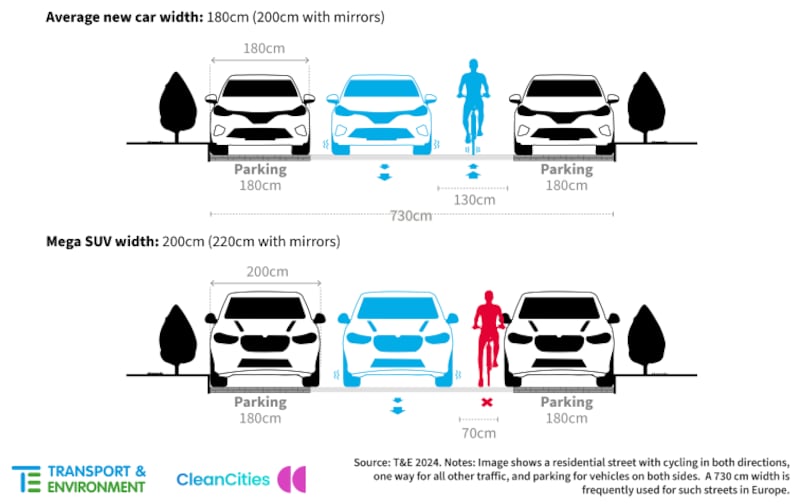As we all count the extra pounds and inches we piled on over Christmas, it’s worth remembering that our cars have been consistently gaining weight at the same time. In fact, according to research by environmental think-tank Transport & Environment (T&E) cars are growing at the rate of 10mm of width every two years on average.
T&E claims that around half of all cars on sale are already too wide for the narrowest standard on-street parking space. Width has long been an easy gain for car makers. Most people blanch at buying a car that’s too long — up to around 5.0-metres is most people’s cutoff point — because they feel it will be too unwieldy in tight spots, but few if any bother to check the width.
Cars have been getting wider in part because of crash testing — more width equals more protection and better ways of tackling the dreaded Euro NCAP side pole impact test, but such safety systems add weight and girth.

Girth to the point where the average car on sale is now 1.8-metres wide, up from 1.77-metres in 2018. More data on the subject, gathered by the International Council on Clean Transport (ICCT) suggests that the trend has been going on since 2000 at least. In theory, there is a maximum width for cars under EU law, but the problem is that it’s the same maximum 2,550mm width as for buses and trucks, so it’s not really much use for restricting the massive growth of average family cars.
RM Block
James Nix, Vehicles Policy Manager at T&E, said: “Cars have been getting wider for decades and that trend will continue until we set a stricter limit. Currently the law allows new cars to be as wide as trucks. The result has been big SUVs and American style pick-up trucks parking on our footpaths and endangering pedestrians, cyclists and everyone else on the road. Among the top 100 models in 2023, 52 per cent of vehicles sold were too wide for the minimum specified on-street parking space of 180 cm in major cities, including London, Paris and Rome, the research also finds. Off-street parking is now a tight squeeze even for the average new car — 180 cm wide — while large luxury SUVs no longer fit. Measuring around 200 cm wide, large luxury SUVs leave too little space for car occupants to get in and out of vehicles in typical off-street spaces of 240 cm.”
According to T&E, the growth in size is very pronounced among large luxury SUVs. In the most egregious cases, the Land Rover Defender grew by 20.6cm (although that’s an anomaly as the current Defender was replacing, essentially, a 1960s design) and the Mercedes X5 by 6cm in just six years. In 2023, Volvo went 4.1cm wider with its XC90-replacing electric EX90. “Carmakers are using this growth of the largest SUVs to also increase the width of vehicles in the midsize and compact segments” says Nix.
Width is only part of the problem. T&E claims that car makers are using the extra width as, in part, an excuse to raise the roof height, improving the exterior styling and making the cabin feel more spacious even if it actually isn’t, expect in height which mostly you can’t use. This flies in the face of advice from the likes of the Belgian VIAS Institute (an equivalent of the UK’s Thatcham car safety research centre) which points out that a 100mm increase in the height of vehicle fronts carries a 30 per cent higher risk of fatalities in collisions with pedestrians.
The tide might just be turning, however. The city of Paris is lining up an extra parking levy for especially heavy and bulky cars, and polling suggests that two-thirds of Parisians are keen on the idea. The referendum takes place next month, and T&E hopes that it might fire the starting gun on other European cities following suit. Barbara Stoll, director of T&E’s Clean Cities Campaign, said: “Monster SUVs are a threat to the urban fabric of our cities. Unless we act now, more and more of our precious public space will be taken away from people by ever larger cars – this is not the cleaner, brighter and greener future that citizens want. On February 4th, Parisians have a unique opportunity to lead the way and say no to these polluting and dangerous giants taking over our streets.”
It also seems that, following several years when most new electric car launches were of increasingly hefty SUVs and crossovers, car makers are now at last starting to roll out more compact models. The new Renault 5 EV launches within weeks, and will be followed later in the year by the Volkswagen ID.2, the Citroen eC3, and a new electric Fiat Panda.
- Sign up for push alerts and have the best news, analysis and comment delivered directly to your phone
- Find The Irish Times on WhatsApp and stay up to date
- Our In The News podcast is now published daily – Find the latest episode here



















